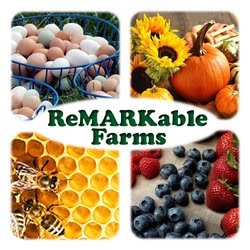On The Farm
Some brief updates from happenings this past fall at ReMARKable Farms and the Wetzel household.
I started some apple wine. Last year, I made hard cider and it is still aging (it is supposed to age for 2 years). So, I decided to try something different and make some apple wine!
I know this is not going to be a popular decision but I have decided that I am NOT going to plant sunflowers to sell as cut flowers next year. I will probably still plant some sunflowers to harvest for the chickens but these will be more for seed and not flowers. Of course, I will still grow some red sunflowers so I can make the red sunflower jelly. Why not grow sunflowers? Time...the sunflowers take a LOT of time and I can never recoup that in profits from sales. The sunflowers has truly been a labor of love the past few years. Now, with Mark's egg business starting, I just don't feel like I will have the time to devote to the flowers. Another reason is that I also want that time to devote to our own personal garden and food preservation which leads me to my next topic...
In the Garden
Here is a list of the items I was able to preserve this past year. Yes, I am patting myself on the back...also, I use this list to help me determine if I need to make more/less for the next year.
Canned:
5 - 1/4 pints cowboy candy
9 pints beets
12 pints pickled beets
8 pints salsa
8 pints rotel - ran our 1/26/20
9 quarts apple pie filling
10 pints applesauce
26 pints hot apples
32 quarts tomato sauce
6 quarts cherry pie filling
cherry jam
12 - 1/2 pints beet ketchup
4 - 3/4 quarts of dilled cauliflower
4 - 3/4 quarts of green enchilada sauce

Frozen:
30 pints green beans
5 pints dragon tongue beans
12 - 1 cup servings of diced onion
9 - 1/2 cup servings of green chilis
15 pints corn
*12 pints broccoli
*7 pints cauliflower
7 -10 oz servings of kale/beet greens
*note to self: freeze in quarts next year
Dehydrated:
celery
green beans
kale
*lots of herbs (oregano, thyme, basil, yarrow flowers and leaves, lemon mint, catnip, dill, echinacea, anise hyssop, sage, bee balm)
*flowers (calendula, chamomile, borage, marigold, nasturium, lavender)
cherry tomatoes
Sunflower seeds
Pumpkin seeds
*most of the herbs and flowers are for treats for the chickens and ducks this winter

Fermented:
4 gallons salsa
carrots
beets
1 1/2 quarts sauerkraut
2 quarts of cauliflower
Canned:
5 - 1/4 pints cowboy candy
9 pints beets
12 pints pickled beets
8 pints salsa
8 pints rotel - ran our 1/26/20
9 quarts apple pie filling
10 pints applesauce
26 pints hot apples
32 quarts tomato sauce
6 quarts cherry pie filling
cherry jam
12 - 1/2 pints beet ketchup
4 - 3/4 quarts of dilled cauliflower
4 - 3/4 quarts of green enchilada sauce

Frozen:
30 pints green beans
5 pints dragon tongue beans
12 - 1 cup servings of diced onion
9 - 1/2 cup servings of green chilis
15 pints corn
*12 pints broccoli
*7 pints cauliflower
7 -10 oz servings of kale/beet greens
*note to self: freeze in quarts next year
Dehydrated:
celery
green beans
kale
*lots of herbs (oregano, thyme, basil, yarrow flowers and leaves, lemon mint, catnip, dill, echinacea, anise hyssop, sage, bee balm)
*flowers (calendula, chamomile, borage, marigold, nasturium, lavender)
cherry tomatoes
Sunflower seeds
Pumpkin seeds
*most of the herbs and flowers are for treats for the chickens and ducks this winter

Fermented:
4 gallons salsa
carrots
beets
1 1/2 quarts sauerkraut
2 quarts of cauliflower

In the Wetzel Household
Lastly, a bit of nerve racking news...I had a phone call in November about Joshua's Medicaid. It seems that we make too much money now so he lost his Medicaid. The Medicaid is paying for his residential treatment. I have no idea how much this costs but I can assume it is a lot of money. My heart just sank. He is definitely not completed with his treatment and I was so nervous that he might be forced to come home. I immediately started making phone calls. It's crazy that his treatment is based on our income. The two seem to be unrelated to me. Anyway, the good news is that I just found out on Friday that Children's Behavioral Health in Idaho is going to take over on Joshua's payment for his treatment. Another thing to be thankful for! A Christmas miracle!
Ready to put 2019 in the books and start a new decade...Merry Christmas and Happy New Year!
~Denise








